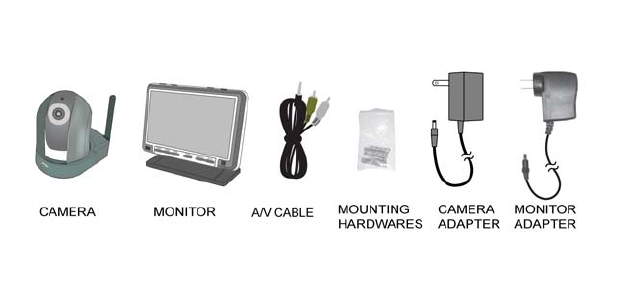RDI Technology CA520 WIRELESS PAN AND TILT CAMERA User Manual Manual for CA520
RDI Technology (Shenzhen) Co., Ltd. WIRELESS PAN AND TILT CAMERA Manual for CA520
USERS MANUAL

Congratulations on your purchase of CMS5270----the 7.0 Inch Wireless Monitoring System with
OSD menu. The system consists of a 7.0” wireless monitor and a wireless color camera, an ideal
product for watching the baby, elder or patient. It is also suited for small business applications.
Features///
1). 2.4GHz wireless technology, 7.0-inch LCD for good picture display
2). Manual switch wired and wireless camera via pressing the button “Source”.
3). Supports up to 3 cameras and each camera’s motion can be armed or disarmed independently.
4). Friendly menu can adjust the alarm volume, contrast, brightness, color and tint.
5). LCD monitor can work with 3 modes: Scan, Auto & Manual
6). Selectable screen ratio of 4:3(std), 16:9(DVD movie) and extended 4:3.
7). Mirror function for vehicle rear view camera.
8). Up/down reverse function when monitor is installed upside down.
9). Optional rechargeable battery pack for both camera and monitor portable use.
10). LCD monitor can be wall or table mounting.
System Contents///
Identify all parts before proceeding with installation.
Things to Consider Before Installation/// For best performance, follow these simple guidelines:
*The camera should be aimed accordingly to optimize viewing area. *For best transmission, avoid
installations where there are thick walls or major obstructions between the camera & LCD
monitor.
Installing the Camera (Transmitter)///
1. Unpack the Camera.
2. The Pan&Tilt camera can only stand on desktop. So attach the camera to stand as shown. The
camera can be adjusted by rotating the camera head to the required position.
3. Use the camera power adaptor, connect power jack to the rear of the tabletop base. Make sure
the camera is within reach of an AC power outlet. Once it’s connected with the adaptor, the
camera will rotate one cycle.
4. After the camera rotate one cycle, press “Privacy” button, the lens will rotate to the lowest
position.
5. Select the camera operating channel on the DIP switch on the bottom panel by moving switches
1, 2 or 3 to the down position. Switch is preset to channel 1. 4. After the camera rotate one cycle,
press “Privacy” button, the lens will rotate to the lowest position.
IMPORTANT: In order to access the DIP switch in the bottom of the camera, you need to reverse
the camera and turn to the bottom.
6. The Camera (Transmitter) installation is now complete.
Night vision///
The Camera includes IR LEDs, which allows viewing in the dark when used with the adapter. It
can automatically turn on night vision in low light.
Installing the LCD Monitor///
1. Unpack the LCD monitor.
2. Decide whether the LCD monitor will be wall-mounted or sit on a desk/tabletop. If wall
mounting, refer the drilling size on the back cover of this manual. If using the tabletop base, attach
the camera to the stand as shown.
3. Plug the LCD monitor AC power plug into the power jack on the rear of the LCD base.
4. Turn on the LCD monitor by pressing the top POWER button.
5. If using the rechargeable battery pack (for your option), when changing the LCD bracket with
that, please follow the schematic as below:
6. If using the wired camera with the monitor, you need to use the A/V cable connecting to the
monitor as shown above on the right side. You can use at most 2wired cameras at the same time.
7. The earphone jack is available.
Optimizing the Wireless Camera System///
The 2.4 GHz signal passes easily through walls, but the signal may be reflected by power wires or
plumbing inside the wall. The most common source of interference is microwave ovens. Try to
avoid mounting the LCD monitor near a microwave oven or other source of RF interference.
Multi-Camera Operation///
The Wireless monitoring System is designed to work with up to three cameras. Additional cameras
are sold separately. Important: When using more than one camera, make sure each camera is
assigned to a specific/different channel by moving the DIP switch to the right position.
The LCD monitor’s DIP switch located on the Bottom panel of the LCD monitor should be
adjusted to reflect the channel in use.
Operating Modes///
The wireless system can be set to operate in one of three modes: Scan, Auto or Manual. The
desired operating mode can be selected using the buttons on the front panel of the LCD monitor.
Scan
Pressing the Scan button places the system in Scan mode. The LCD monitor screen blanks into a
standby mode while the system continuously scans the active cameras. If a camera detects motion,
the LCD monitor displays picture from the camera and the beeper will sound. Several minutes
after the last detection, the screen returns to standby mode while the LCD monitor resumes
scanning. Pressing the Manual or Auto button will cancel this mode.

Auto
Pressing the Auto button places the system in Auto mode. In this mode, the system automatically
rotates through all active cameras. When a camera detects motion, the LCD monitor will display
the picture from the camera for a few seconds, and the beeper will sound. To avoid searching
channels that do not have cameras/transmitters assigned to them, set the DIP switches (located on
the bottom panel of the LCD monitor) for those corresponding channels to the off position. The
dwell time (time taken to switch between cameras) is preset to 4 seconds and can be adjusted
between 2 - 30 seconds. To adjust the dwell time, press both the Auto and Manual buttons
simultaneously. Each flash of the LED increases the dwell time by one second.
Manual
To select a specific camera to LCD monitor, press the Manual button. The LCD monitor will
switch to a different camera each time the Manual button is pressed. When a camera detects
motion, the beeper on the LCD will sound. To avoid searching channels that do not have cameras
assigned to them, set the dip switches (located on the bottom panel of the LCD monitor) for those
corresponding channels to the OFF position.
Arm/Disarm
Each camera By using the Cam1, Cam2 and Cam3 buttons, you can arm or disarm each camera
independently. When pressing one of the buttons, it will turn green. This means the camera is
armed and beep sound can be heard. By pressing again, the camera is disarmed.
Monitor Functions///
Power
Press to turn the monitor on/off.
Source
Press to switch the monitor to work as wired monitor only or wireless.
Menu
By pressing the Menu button, you can cycle through the Alarm Volume, Brightness, Contrast,
Color, Tint, Mirror, Up/Down and Display Mode.
Volume Adjust
Adjust Volume setting and parameters as above.
Trouble Shooting///
If you are having trouble operating this product, please consult the guide below:
Symptom Remedies
No Camera
picture
1. Check all connectors. Make sure camera(s) & monitor switched
ON.
2. Ensure camera(s) & monitor are set to correct channel(s).
3. Make sure camera(s) is within range of monitor (receiver).
Blank Monitor 1. Make sure monitor is switched ON.
2. If using AC adaptor, make sure it is plugged in.
3. Make sure rechargeable battery is charged.
Interference on
Camera picture
1. Make sure each camera (transmitter) is within range, and that
no large obstructions are blocking the signal.

2. Try repositioning the camera, monitor or both to improve the
reception quality.
3. Reposition other nearby equipment transmitting on the 2.4 GHz
frequency.
Audio Problems 1.Ensurne
d
up sufficiently on the monitor
2. Make sure the sound is within the microphone range.
3. If the units emit a loud wailing sound (feeds back), try moving
the camera away from the monitor or angle the monitor
differently.
Symptom Remedies
No Camera
picture
1. Check all connectors. Make sure camera(s) & monitor switched
ON.
2. Ensure camera(s) & monitor are set to correct channel(s).
3. Make sure camera(s) is within range of monitor (receiver).
Blank Monitor 2. Make sure monitor is switched ON.
2. If using AC adaptor, make sure it is plugged in.
3. Make sure rechargeable battery is charged.
Interference on
Camera picture
1. Make sure each camera (transmitter) is within range, and that
no large obstructions are blocking the signal.
2. Try repositioning the camera, monitor or both to improve the
reception quality.
3. Reposition other nearby equipment transmitting on the 2.4 GHz
frequency.
Audio Problems 1.Ensurned up sufficiently on the monito
r
2. Make sure the sound is within the microphone range.
3. If the units emit a loud wailing sound (feeds back), try moving
the camera away from the monitor or angle the monitor
differently.
Symptom Remedies
No Camera
picture
1. Check all connectors. Make sure camera(s) & monitor switched
ON.
2. Ensure camera(s) & monitor are set to correct channel(s).
3. Make sure camera(s) is within range of monitor (receiver).
Blank Monitor 3. Make sure monitor is switched ON.
2. If using AC adaptor, make sure it is plugged in.
3. Make sure rechargeable battery is charged.
Interference on
Camera picture
1. Make sure each camera (transmitter) is within range, and that
no large obstructions are blocking the signal.
2. Try repositioning the camera, monitor or both to improve the
reception quality.
3. Reposition other nearby equipment transmitting on the 2.4 GHz
frequency.

Specification///
Camera (Transmitter):
TV System PAL/NTSC
standard Image Sensor 1/3" CMOS
Integrated Lens 5.6mm, F2.0 fixed focus
Resolution 360 horizontal TV lines
Signal/Noise Ratio 48db
Frequency Range 2.41-2.47GHZ
Weather proof Indoor
Mini. Illumination 0.1Lux
Current Consumption 200mA
Modulation FM
PIR Range & Angle 6m,90°
Overall size 2.36"(W) x 2.76"(H) x3.07"(D)
Transmission Range 500 feet
Monitor (Receiver)
TV System PAL or NTSC
standard Frequency Range 2.41~2.47GHz
Screen Size 7.0 inch
Resolution 1440 x 234 dot
Power Supply DC 9V, 2.0 A
Brightness 300cd/ m2
Contrast Rate 150:1
Color Configuration RGB Stripe, full color
Operating Temperature -10°C+40°C
overall Size 7.1”W*4.6”H*1.3”D
Signal Source Wireless A/V, PIR
Battery:
Voltage: 7.4V
Rechargeable Battery(For
Monitor)
Approx 2 hr. continuous
3 hrs. standby
General:
Operating temperature: -10°C to 40°C
14°F to 104°F
Humidity: Less than 85%
Approvals///
This device complies with part 15 of the FCC rules. Operation is subject to the following two
conditions:
(1)this device may not cause harmful interference, and
(2)this device must accept any interference received, including interference that may cause
undesired operation
FCC NOTE
The manufacturer is not responsible for any radio or TV interference caused by unauthorized
modifications to this equipment. Such modifications could void the user's authority to operate the
equipment.
Warranty ///
This product has one-year manufacturer’s warranty, which covers parts and labor only. In the
unlikely event that you encounter a technical or quality issue, please contact local distributor, we
will replace defective units within the warranty period.